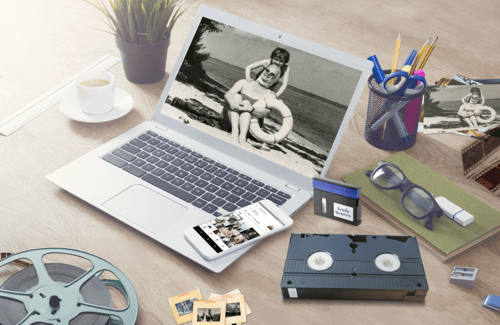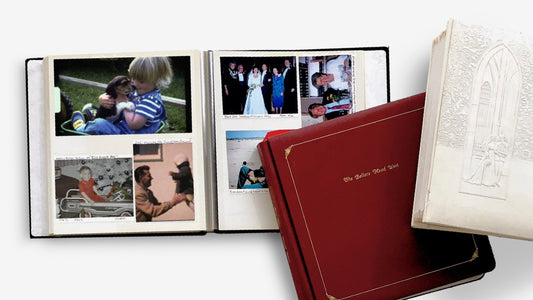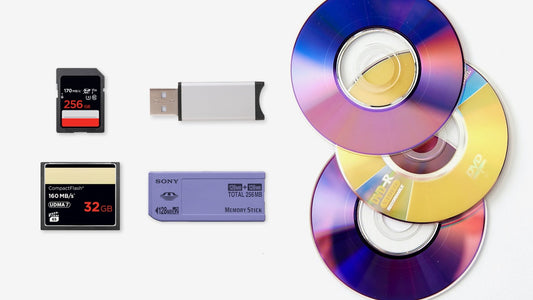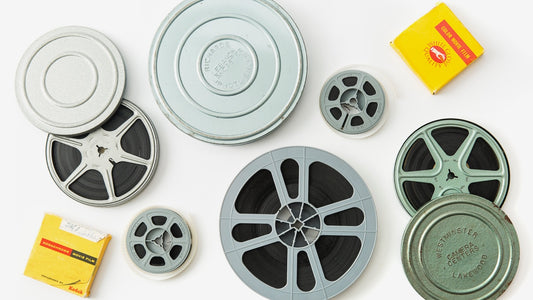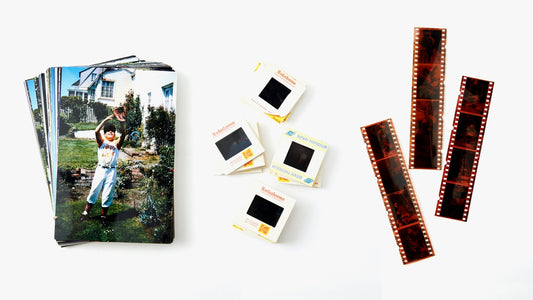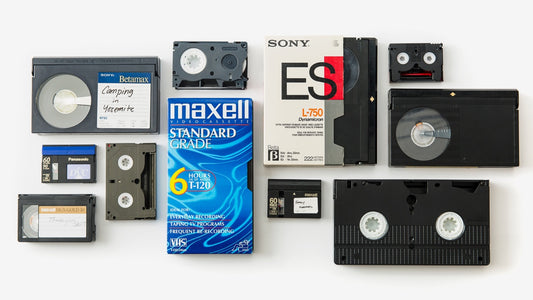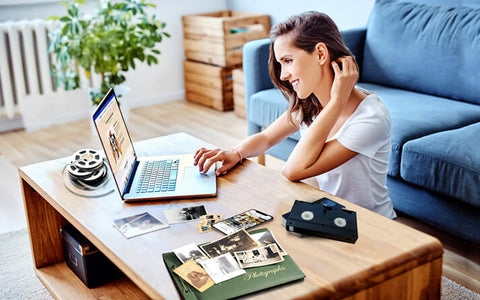Every family has a unique story, and often, significant chapters of that story are captured on VHS tapes. From baby's first steps to unforgettable family vacations, these recordings are invaluable. However, the clock is ticking on the lifespan of these tapes. The magnetic media can deteriorate, and playback devices are fading into history. This is why considering a vhs transfer to digital is such an important step. It’s more than just a technical process; it’s an act of preservation, ensuring that your family’s visual legacy is protected and can be easily passed down, viewed, and cherished by everyone, now and in the future. Let's look at how you can make this happen smoothly.
Key Takeaways
- Future-Proof Your Footage: Act now to convert your VHS tapes to digital; this shields your home movies from physical wear and makes them accessible on all your current devices.
- Weigh Your Conversion Options: Carefully consider if a professional service, with its specialized equipment and convenience, or a DIY setup, offering more control, is the right fit for your tapes and technical comfort.
- Organize and Back Up Your Digital Treasures: Once digitized, establish a solid backup system using cloud storage and physical drives, and organize your video files so you can easily find and enjoy them for years.
What Exactly is VHS to Digital Transfer?
If you've got a collection of old home movies gathering dust, you might be wondering what "VHS to digital transfer" actually involves and why it's something worth doing. It sounds a bit technical, but it's really quite straightforward. Let's walk through what it means and why it’s a smart move for your precious memories.
Defining "VHS to Digital"
At its core, VHS to digital transfer is the process of taking the video content from your old VHS tapes and moving it into a modern, digital format. Think of it as carefully translating an old, beloved book into a language everyone can easily read and access today. This involves converting the analog signals—the way information was physically stored on those magnetic tapes—into a digital file. This digital file can then live on your computer, a USB drive, or even in the cloud. Typically, this requires specific hardware, like a VHS player connected to a special converter or a capture card, which reads the tape and translates its contents into digital data.
Why Should You Convert Your VHS Tapes to Digital?
So, why go through this process? Well, those cherished VHS tapes, unfortunately, aren't designed to last forever. Over time, usually within 10 to 25 years, the magnetic tape inside them can start to degrade. This can lead to fuzzy pictures, distorted sound, or, heartbreakingly, the complete loss of your footage. Plus, finding a working VCR these days can feel like an archaeological dig! By choosing to transfer your videos to a digital format, you're essentially giving them a new lease on life and making them future-proof. Digital files are far easier to store securely, make copies of (hello, peace-of-mind backups!), and share with family and friends, no matter where they are in the world. It’s the best way to ensure those irreplaceable moments are protected and can be enjoyed for many years to come.
Who Can Convert Your VHS Tapes Professionally?
If the idea of tackling your VHS tape conversion project on your own feels a bit daunting, you're certainly not alone! Many people choose to entrust their precious memories to professional services, and for good reason. Handing over your tapes to experts can save you a significant amount of time and potential frustration. These services have the specialized equipment and experience to handle older, sometimes delicate, media, often producing higher quality digital files than you might achieve with consumer-grade DIY setups. Plus, they take on the responsibility of the entire video transfer process, from initial assessment to final digital delivery, which can be a huge relief.
When you're looking for a professional service, it's a good idea to consider a few things. Think about how quickly you need your tapes converted, as turnaround times can vary. Check what digital formats they offer – common options include MP4 files on a USB drive, DVD, or cloud storage. You'll also want to feel confident that your irreplaceable tapes will be handled securely and returned to you safely. Reading customer reviews and understanding their process for tracking and handling orders can provide peace of mind. The good news is there are several reputable companies out there ready to help you bring your VHS memories into the digital age. Let's look at some of the well-known options.
YesVideo
YesVideo is a fantastic choice if you're looking for a comprehensive service that really understands the ins and outs of digitizing tapes. They specialize in transforming those aging VHS tapes into modern digital formats, making it super easy for you to watch, share, and enjoy them again. What I appreciate about YesVideo is their commitment to guiding you through the process. They offer clear information, helping you understand everything from how the conversion works to managing your newly digitized videos. They handle all orders by hand in the USA, which adds a layer of trust when you're sending off such precious items. They aim to make your memories accessible for generations to come.
CVS Photo
Many of us are familiar with CVS for pharmacy needs and photo prints, but did you know they also offer a home movie transfer service? This can be a really convenient option, especially if you have a local CVS nearby. You can typically drop off your VHS tapes and other old media, and they'll handle the conversion to digital formats for you. The main goal here is to help you preserve those cherished family moments by making them viewable on current devices. It’s a straightforward way to get your tapes digitized without needing to become a tech expert yourself, making memory preservation accessible to everyone.
Walmart
Walmart also provides a video transfer service designed to help you digitize a variety of old media, including your VHS tapes, film reels, photos, and slides. This service is all about safeguarding your memories by converting them into formats that are not only easier to share with family and friends but are also less susceptible to the wear and tear that physical tapes can suffer over time. Given Walmart's widespread presence, this can be an accessible option for many people looking to protect their family history. They aim to make the process of preserving your past straightforward and convenient.
Walgreens
Similar to CVS, Walgreens Photo offers a home movie and print digitization service that can take your old VHS tapes and convert them into digital formats. This is another convenient local option for those looking to preserve their memories without investing in their own equipment. The focus is on ensuring your treasured moments, captured on aging media, are safeguarded for many years to come by bringing them into the digital age. By converting your tapes, you make them easier to view, share, and enjoy with loved ones, ensuring those memories continue to be a part of your family's story.
Costco
If you're a Costco member, you might find video transfer services available through their photo centers. While Costco itself may partner with specialized companies to perform the actual digitization, they offer a convenient drop-off point. This is part of a broader trend where general stores and retail chains provide access to such services, making it easier for you to preserve your memories without having to ship them off to an unknown company. It’s worth checking with your local Costco Photo Center to see what options they currently provide for converting your VHS tapes and other old media into lasting digital keepsakes.
Southtree
Southtree built its reputation by specializing in video-to-digital services, with a strong focus on helping families safeguard their precious memories. They were known for their capability to transfer all sorts of video tape formats into modern digital ones, ensuring that those irreplaceable moments weren't lost to time or degrading tapes. While Southtree is now part of the Legacybox family, their original mission was centered on providing a dedicated service for preserving family histories. This expertise in handling various tape formats made them a go-to for many people looking to convert their home movies.
Legacybox
Legacybox is a well-known name in the world of media digitization, offering services to convert your VHS tapes to digital formats with several convenient options for receiving your memories. You can choose to get your digitized videos on DVD, a thumb drive, or via cloud storage, making it really simple to access and share your cherished moments. They aim to make the entire process of preserving your family history as easy as possible. You send them your tapes (and other old media like photos and film), and they handle the conversion, returning your originals along with your new digital copies.
Prefer to Go DIY? Your VHS to Digital Options
So, you're thinking about tackling the VHS to digital conversion yourself? I totally get it! Going the DIY route can be a really rewarding project, especially if you enjoy figuring things out and have a bit of a techy side. It definitely gives you direct control over the whole process from start to finish. However, it’s good to be realistic about what’s involved. It can be quite time-consuming, and the quality of your digital files can vary depending on your equipment and know-how. If you have a big stack of tapes, or if those tapes hold truly irreplaceable memories, a professional video transfer service like ours at YesVideo can save you a lot of time and potential frustration, ensuring your memories are preserved with the best possible quality. But if your heart is set on giving it a go yourself, let's explore your main options.
Option 1: Use a VCR and a Capture Device
This is a pretty common method for DIY enthusiasts. You’ll need a working VCR (yes, you'll have to dust that off or find one!), your computer, and an analog-to-digital video capture device. This little gadget is key, as it acts as the bridge connecting your VCR to your computer, usually through a USB port. You'll play your VHS tape on the VCR, and the capture device, along with its accompanying software, will record the playback, saving it as a digital file on your computer.
For the best results with this setup, it’s super important to check the tracking settings on your VCR. Sometimes, a small adjustment there can significantly improve the picture clarity. If you run into any snags, like a fuzzy image or no signal at all, a good first troubleshooting step is to check the RCA cable connections between your VCR and the capture device. This method offers a good amount of control, but be prepared for a bit of a learning curve and some patience.
Option 2: Try an All-in-One VHS to Digital Converter
Another route you might consider is an all-in-one VHS to digital converter. These are standalone devices that often look a bit like a compact VCR. Their main appeal is that they can record directly to an SD card, a USB drive, or sometimes even burn to a DVD, meaning you don't necessarily need a computer for the initial capture process. They certainly sound convenient, and for some situations, they might be just fine.
However, it's worth noting that the quality you get from these all-in-one units can be a bit unpredictable. If you’re only looking to digitize one or two tapes and aren’t overly concerned about achieving pristine picture and sound, these converters might do the trick. But, as some tech reviewers point out, for anything more than a couple of tapes, or for footage that holds deep sentimental value, you could be gambling with your footage. These devices often don't have the more sophisticated calibration options or cleaning mechanisms that professional services use to get the best out of old tapes.
Option 3: Choose Software for Editing and Enhancing
Once you’ve successfully converted your VHS tapes to digital files using either of the methods we've talked about, your DIY adventure isn't quite finished. You'll likely want to do some editing on your newly digitized videos. This could involve simple tasks like trimming out any unwanted blank sections at the beginning or end, or perhaps you'll want to adjust the brightness, contrast, or color to make the videos look their best. You might even want to add titles or captions. There's a wide range of video editing software out there, from free, basic programs to more advanced, feature-rich paid options.
After all your hard work, you also need a solid plan for how to store these digital video files. Just leaving them on your computer’s main hard drive isn’t the safest long-term strategy. Keeping them stored in the cloud is a fantastic option, offering security and accessibility. External hard drives or USB flash drives are also great for creating backups. The ultimate goal, after all, is to ensure these precious family memories are kept safe and sound, ready to be enjoyed for many years to come.
How Does the VHS to Digital Transfer Actually Work?
It might seem like a bit of a mystery, but converting those beloved VHS tapes into digital files is actually a pretty straightforward process, whether you decide to hand them over to professionals or tackle it yourself. Think of it as giving your memories a modern makeover so they can live on for years to come, easily shareable and safe from the wear and tear that old tapes inevitably face. At its heart, the process involves taking the analog video and audio signals stored on the magnetic tape inside your VHS cassette and transforming them into a digital format. This digital version is essentially a computer file, like an MP4, which can be played on your computer, smartphone, smart TV, or tablet. It means no more hunting for a working VCR!
The magic happens through a combination of playback hardware (your VCR or a professional deck) and capture technology. The VCR reads the tape, and then a special device or software records that information, converting it into ones and zeros that make up a digital video file. This not only preserves the visual and audio content but also stops any further degradation that physical tapes suffer over time, like color fading or sound distortion. Once digitized, your home movies are much easier to organize, edit if you wish, and, most importantly, share with family and friends, no matter where they are. We'll walk through the typical steps involved, from preparing your tapes to finally enjoying your newly digitized memories, so you know exactly what to expect.
First, Get Your Tapes Ready
Before you even think about converting, a little prep work can go a long way. As the experts at YesVideo often say, "Before shipping off your precious memories, taking a few simple steps to prepare your VHS tapes can make a big difference in the quality of your digital conversions." Start by gathering all your tapes and giving them a quick inspection. Look for any visible damage to the cassette or the tape itself. If they're dusty, gently wipe the cassette casing with a soft, dry cloth. It's also a great idea to label each tape clearly if they aren't already – this will be a lifesaver for organization later. Make sure your tapes are fully rewound; this helps ensure a smooth playback during the transfer. These small actions can really help the video transfer process.
Next, Decide: Professional Service or DIY?
This is a key decision point. You can either entrust your tapes to a professional service like ours at YesVideo, or you can tackle it as a do-it-yourself project. There are definitely many ways to process VHS tapes, and as Moving Memories points out, "A common concern is whether DIY conversions can have positive results — indeed, with the right tools and techniques, it is certainly possible to achieve 'good enough' results." Choosing a professional service means less hassle for you and access to high-quality equipment and expertise. It's perfect if you have a lot of tapes, value convenience, or want the best possible quality. Going the DIY route can be a rewarding project if you're tech-savvy and have fewer tapes. It gives you full control but requires an investment in equipment and your time. Consider what matters most to you: convenience, cost, quality, or the hands-on experience.
If You Choose a Pro: Dropping Off or Mailing Tapes
If you opt for a professional service, the process is designed to be easy for you. Many local spots might offer conversion, as Capture notes, "Many areas have local services that can turn old VHS recordings into digital formats...it's more likely that it will be part of a local drugstore, pawn shop, general store, or other establishment." However, for a specialized and trusted experience, services like YesVideo allow you to mail in your tapes securely. You'll typically receive a welcome kit with instructions and a sturdy box for shipping. You pack your tapes, send them off, and the professionals handle the rest, using specialized equipment to carefully convert your memories. Once done, you'll get your original tapes back along with your new digital files on a DVD, USB, or via a cloud link.
If You Go DIY: Setting Up Your Equipment
If you're taking the DIY path, your first step is gathering and setting up the necessary gear. You'll typically need a working VCR (this is crucial!), a computer, and a VHS-to-digital video capture device. This device acts as a bridge, connecting your VCR to your computer. You'll also need software to capture and edit the video. Once you have everything, connect the VCR to the capture device, and then the capture device to your computer. As the folks at Convert My Tape wisely advise, "When converting VHS tapes to digital, it’s important to check the tracking settings on my VCR." Properly adjusting the tracking can significantly improve picture quality, reducing fuzziness or lines.
Finally, Receive or Create Your Digital Files
This is the exciting part – seeing your old memories in a new format! If you used a professional service, they'll deliver your digital files in the format you selected, like MP4 files on a USB drive, DVDs, or a secure cloud account for easy viewing and sharing. You'll also get your original tapes back. If you went the DIY route, "After your DIY project is complete, you need to decide how to store the digital video files," as ScanCafe highlights. Your capture software will save the video as a digital file on your computer. From there, you can transfer these files to a USB drive, an external hard drive, or upload them to cloud storage. Now your memories are preserved and ready to be enjoyed all over again!
What to Expect: Costs and Key Considerations for VHS to Digital
Figuring out the best way to convert your VHS tapes to digital involves looking at both the price and what you get for your money. It's not just about the cheapest option, but about finding the right balance of cost, quality, convenience, and peace of mind for your precious memories. Let's walk through what you should consider so you can make a choice you feel great about.
Understanding Professional Service Pricing
When you opt for a professional video transfer service, you're generally paying for expertise and convenience. Typically, these services charge per tape. You can expect prices to range from about $15 to $35 for each VHS tape you want to convert. This fee usually covers the basic digitization process, turning your analog memories into modern digital files.
If you'd like extra copies of your newly digitized memories, say on a DVD or a USB drive, there will likely be an additional charge. These copies can cost anywhere from $5 to $20 each. While it might seem like these costs add up, remember you're paying for a hands-off process where experts handle the technical work, ensuring your memories are safely and effectively preserved for years to come.
Breaking Down DIY Method Expenses
If you're thinking about tackling the conversion yourself, the costs can vary quite a bit. One of the main DIY routes involves using a VHS to digital converter device. These converters typically cost between $50 and $300. Of course, you'll also need a working VCR or camcorder; if you don't already have one, that's an added expense to factor in.
While using a converter can be a more budget-friendly initial outlay compared to per-tape professional fees, especially if you have many tapes, it's important to weigh this against the time you'll invest and the quality you might achieve. Some people try a simpler DIY method using just a camcorder and VCR, which could be free if you own the equipment, but this often results in lower quality and can be very time-consuming.
Don't Overlook Potential Hidden Costs
Beyond the sticker price of a service or the cost of DIY equipment, there are other important factors that have their own "cost," whether in time, effort, or risk. When you're choosing a professional service, ask about their turnaround time. How long will it take to get your tapes and digital files back? For many, quicker is better, especially if there's an event or holiday coming up.
Also, consider the security measures the service has in place. These are your irreplaceable memories, so you want to ensure they’re handled carefully. Look for services that offer guarantees on their work. What happens if a tape is damaged or the quality isn't what you expected? Knowing these details upfront can save you headaches later and helps ensure you’re entrusting your tapes to a reliable provider like YesVideo, who processes all orders by hand in the USA.
Factoring in the Time and Effort Involved
The DIY approach can certainly seem like the most economical path, but it's crucial to honestly assess the time and effort required. Converting VHS tapes yourself isn't just a plug-and-play task; it demands a good chunk of your time, especially if you have a large collection. Each tape needs to be played in real-time to capture it, and then there's the setup and any troubleshooting.
Moreover, achieving good quality with DIY methods often requires some technical know-how. You might need to fiddle with settings or software to get the best results. If you're not particularly tech-savvy, or if your time is limited, the apparent cost savings of DIY might be outweighed by the frustration and the hours spent. Sometimes, investing a bit more for a professional service means you save valuable time and get a higher-quality result without the stress.
Want High-Quality Digital Videos? Here’s How to Get Them
When you're ready to convert your VHS tapes, your main goal is to get the best possible digital version of those irreplaceable memories. While professional services handle the technical side to ensure great quality, if you're exploring a DIY path, a few key steps can significantly improve your results.
Keep Your Equipment Maintained and Clean
A clean VCR is your first step toward clear digital videos. Over time, tape residue and dust can build up on the VCR’s heads, leading to a fuzzy or distorted picture. Before you begin a conversion project, it's wise to clean these heads using a VCR head cleaning tape or specialized cleaning swabs. This simple action can make a noticeable difference in playback quality, ensuring your memories are captured as clearly as possible.
Adjust Video Format Settings for Best Results
If you're using software with a capture device, take a moment to explore the video format settings. The defaults might not always be optimal for older VHS tapes. Experimenting with resolution or bit rate, or even trying a different program, can sometimes yield better results. Also, ensure the driver software for your capture device is current; this helps maintain audio and video synchronization for a smoother final video.
Select the Right Equipment for Your Needs
The quality of your VCR and capture device directly impacts your digitized videos. While it might be tempting to use any available equipment, for tapes holding precious memories, it's often worth it to invest in a quality setup. A VCR with S-Video output, paired with a reliable capture device, can offer a cleaner signal and a more faithful digital transfer, especially for a large collection or particularly sentimental tapes.
Make Tracking Adjustments for Clearer Playback
Seeing annoying static lines or a jumpy picture on your VHS playback? That's often a tracking issue. Tracking refers to how the VCR heads align with the recording on the tape. Most VCRs have tracking adjustment buttons or a dial. Before you start your digital recording, play the tape and carefully adjust the tracking until the picture is as stable and clear as you can get it. This small tweak can significantly enhance the visual quality of your conversions.
Smart Ways to Store and Share Your New Digital Videos
Once you've successfully converted your VHS tapes to digital, the next exciting step is figuring out the best ways to keep those precious memories safe and share them with your loved ones. You've rescued them from fading tapes; now let's make sure they last for generations to come and are easy for everyone to enjoy. Thinking about storage and sharing from the get-go means your newly digitized videos will bring joy for years, not just sit on a forgotten hard drive. It’s all about making those moments accessible and secure, so let's explore some smart options.
Explore Cloud Storage Options
Cloud storage services are fantastic for both safekeeping and sharing your digital videos. Think of it as your personal online vault that you can access from almost anywhere. As one expert notes, "Keeping them stored in the cloud is better than sending the files via email... it gives your family better access to the videos to look at and burn them onto DVDs or download them if they want a copy for themselves." Many services like Google Drive, Dropbox, or iCloud offer a good amount of free storage, with options to upgrade if your collection of digitized home movies grows. This way, everyone you want to share with can relive those cherished moments, no matter where they are, without you having to manage bulky attachments.
Use External Hard Drives and USBs
For a physical backup you can hold in your hand, external hard drives and USB flash drives are excellent choices. These devices allow you to create a tangible archive of your digital memories. With a little care, "you can create a high-quality digital archive that lasts far longer than any tape ever could." External hard drives offer large storage capacities, perfect for extensive video libraries from your film transfer, while USB drives are great for smaller collections or for easily transporting files to share with family during gatherings. Consider getting a couple – one to keep at home and another stored safely elsewhere, just in case. This gives you an extra layer of security for those irreplaceable videos.
Always Create Backups (It's Important!)
This might sound a bit repetitive, but it’s truly crucial: always, always create backups of your digital videos. Technology can be unpredictable, and you don't want to risk losing your newly digitized memories due to a single hard drive failure or a cloud account issue. After your video transfer is complete, your first step should be to decide on your backup strategy. A good rule of thumb is the 3-2-1 backup rule: keep at least three copies of your files, on two different types of media (like an external hard drive and cloud storage), with one copy stored off-site (like at a trusted relative's house or in a safety deposit box). This might seem like a lot, but the peace of mind it brings is invaluable.
Organize Your Digital Video Library
Now that your videos are digital, organizing them will make finding and enjoying specific moments so much easier. Instead of a pile of unlabeled tapes, you can create a neatly structured digital library. As you'll want to store and share those precious memories after converting your VHS tapes, start by creating folders, perhaps by year, event ("Summer Vacation 1998"), or family member. Rename your video files with descriptive titles – "Sarah's 5th Birthday Party" is much more helpful than "VIDEO001.mp4." You might also consider adding tags or metadata if your storage solution allows it. Taking a little time to organize your digital files means you can quickly find that hilarious holiday clip or touching wedding moment whenever you want to relive it.
Got Questions About VHS to Digital? Let's Clear Things Up
It's completely normal to have a bunch of questions when you're thinking about converting your precious VHS tapes. After all, these aren't just tapes; they're your memories! Let's tackle some of the most common concerns to help you feel confident about making the switch.
What About the Quality of Converted Videos?
This is a big one, and rightly so! The quality of your final digital videos depends on two main things: the original condition of your VHS tapes and the equipment and process used for the conversion. If your tapes have been stored well, you're already ahead. Professional services, like us here at YesVideo, use high-quality equipment and refined processes designed to get the best possible video transfer from your tapes. While we can't magically make a very degraded tape look brand new, our goal is to create a faithful digital copy that preserves its current state. For tapes with significant sentimental or archival value, investing in a professional service ensures a "decent capture setup" is used, which is key for creating a high-quality digital archive that lasts.
Is There a Risk of Losing My Memories?
The thought of losing irreplaceable memories is scary, I understand. But here’s some reassuring news: converting your VHS tapes to digital is actually one of the best ways to prevent memory loss. Physical tapes naturally degrade over time – factors like heat, humidity, and even just playing them can cause wear and tear. By preserving memories in a digital format, you're creating a more durable and stable copy that can be easily stored on your computer or in the cloud. Professional services are experienced in handling delicate older media with the utmost care. At YesVideo, every order is processed by hand in the USA, ensuring your precious tapes are treated with the respect they deserve throughout the entire digitization journey.
Will My Digital Files Work on My Devices?
Absolutely! The whole point of converting your tapes is to make your memories accessible and easy to enjoy on your current devices. Reputable conversion services, including YesVideo, typically provide your videos in common digital formats, like MP4. These files are compatible with most computers, smartphones, tablets, and smart TVs, so you can easily watch and share them. This means you can easily view your digitized memories, share them with family and friends, and even do some light editing if you wish. Once digitized, storing them on an external hard drive or in cloud storage is straightforward, ensuring they're safe and accessible without gambling on outdated playback methods.
How Are My Tapes and Digital Files Kept Secure and Private?
Your memories are deeply personal, and their security and privacy are paramount. When you entrust your tapes to a professional service, it's important to choose one that clearly outlines its security measures. At YesVideo, we understand the trust you place in us. We handle all media in our secure US-based facility, and our dedicated team is trained to manage your original tapes and the resulting digital files with the utmost care and confidentiality. The goal is always to keep family memories alive safely and help you share them securely. If you're considering a DIY approach, make sure you establish a secure process for handling your tapes and for storing your digital files, which should always include creating reliable backups.
Top Tips for a Smooth VHS to Digital Transfer
Converting your cherished VHS tapes to digital format is such a wonderful way to bring those precious, often fading, memories into the present and ensure they last for generations to come. I know the idea of tackling this project, whether you're thinking of doing it yourself or entrusting your tapes to a professional service, can sometimes feel a bit overwhelming. Where do you even begin? What if something goes wrong? These are totally normal questions! That's why I've put together this collection of top tips – think of it as your friendly, straightforward guide to making the entire VHS to digital transfer process as smooth and stress-free as possible.
My goal here is to help you feel confident and prepared, no matter which path you choose. We'll cover key considerations that can significantly impact the quality of your final digital videos, from simple checks you can do at home to understanding when it might be best to call in the experts. Preserving these irreplaceable moments, those family holidays, birthdays, and everyday snippets of life captured on tape, is a truly rewarding endeavor. And with a little know-how, you can ensure that the journey from analog to digital is not just successful, but maybe even enjoyable. These tips are designed to help you protect your legacy, avoid common pitfalls, and ultimately, get you closer to easily sharing and reliving those wonderful memories with family and friends for many years ahead. So, let's get you set up for success!
Always Test One Tape Before Converting Them All
Before you commit your entire VHS library to the conversion process, it’s a really smart idea to start with a single tape as a test run. This initial step can save you a lot of time and potential frustration later on, especially if you're taking the DIY route. This trial allows you to check critical settings, like the tracking on your VCR. If the tracking is off, you might end up with a fuzzy or distorted picture, but you can often improve the quality by carefully adjusting it. Testing one tape also gives you a chance to get comfortable with your capture device and software, ensuring everything is working correctly before you proceed with your most irreplaceable memories.
Consider Editing and Enhancing Your Digital Files
Once your VHS tapes are successfully digitized, the creative possibilities don't stop there! You now have versatile video files that you can refine and personalize. Think about taking some time to edit your digital videos; you can easily trim away any blank segments, accidental recordings, or parts you simply don’t need. Many user-friendly video editing software programs also allow you to add titles, incorporate background music, or even combine clips from different tapes to create a highlight reel. Furthermore, you can often enhance the visual quality by adjusting brightness, contrast, or color balance, which can breathe new life into older footage, making those memories even more vibrant.
What Should You Do with Your Original Tapes?
After you’ve digitized your VHS collection and have your memories safely preserved as digital files, you'll naturally wonder about the fate of the original tapes. There isn't a one-size-fits-all answer here; it largely depends on your personal preference and available storage space. Some people feel more comfortable keeping their original VHS tapes as an extra backup or for sentimental reasons, tucking them away in a cool, dry place to prevent deterioration. Others, feeling confident in their multiple digital backups, might choose to declutter and responsibly dispose of the old tapes. Whichever path you lean towards, the most important thing is to ensure your new digital files are securely stored and backed up in more than one location before making a final decision about the physical tapes.
Know When It's Best to Seek Professional Help
While converting VHS tapes to digital yourself can be a fulfilling project, there are certainly situations where entrusting the job to professionals is the better approach. If you're looking at a mountain of tapes, the sheer time and effort for a DIY conversion can be quite daunting. Moreover, if your tapes are particularly old, show visible signs of wear or damage (like mold), or hold immense sentimental or historical value, a professional video transfer service like YesVideo has the specialized equipment and crucial expertise to handle them with the utmost care. If you're not particularly tech-savvy or simply want the peace of mind that your precious memories are in experienced hands, investing in a professional service is often a very wise decision.
Related Articles
- Convert VHS to Digital: The Ultimate 2024 Guide – YesVideo
- VHS Tape to Digital: The Ultimate 2024 Guide – YesVideo
- Change VHS to Digital: The Ultimate 2024 Guide – YesVideo
- Best VHS Video to Digital Converters: Top Picks – YesVideo
- Video Tape to Digital: DIY or Pro? Your Best Bet – YesVideo
Frequently Asked Questions
My VHS tapes are pretty old and some look a bit worse for wear. Can they still be turned into digital files? It's definitely a common concern when you're dealing with older media. In many cases, even tapes that are decades old or show some signs of wear can still be successfully converted. Professional services are generally well-equipped to handle delicate or aged tapes, often using specialized cleaning and playback equipment to get the best possible transfer. If you're considering a DIY approach with fragile tapes, it might be riskier, as consumer-grade equipment isn't always as gentle.
I'm excited to see my old videos! How long will I typically have to wait to get my digital files back from a professional service? The time it takes to get your digital memories back can vary from one service to another and often depends on how many tapes you're converting and how busy the service is at that moment. Some companies might offer different turnaround time options, perhaps with an expedited service for an additional fee. Your best bet is to check directly with the service you're considering; they can give you a more precise estimate based on your specific order.
I'm not exactly a tech whiz. Should I even attempt to convert my tapes myself, or is a professional service the way to go for someone like me? That's a great question, and it really comes down to your comfort level and how much time you have. While DIY conversion can be a rewarding project, it does involve a bit of a learning curve with equipment and software. If you're not keen on troubleshooting technical setups or investing time in the process, a professional service is often a smoother path. They handle all the technical aspects, ensuring your memories are converted with care and good quality, which can be a huge relief.
After my home movies are digitized, what’s a simple way to let my family, especially those who live far away, watch them too? Sharing those newly digitized memories is one of the best parts! Cloud storage services are incredibly convenient for this. You can upload your video files to a secure online platform, and then share a link with your family members, allowing them to view or download the videos from anywhere. Many professional services, including YesVideo, offer cloud access as part of their packages. For sharing in person, having your videos on a USB drive is also a simple and portable option.
If I send my tapes to a company like YesVideo, will I get my original VHS tapes back along with the new digital versions? Yes, absolutely. Reputable professional conversion services, including YesVideo, understand the sentimental value of your original tapes. They will always return your original media to you once the digitization process is complete. You'll receive your new digital files on the format you selected—like a USB drive, DVDs, or through a cloud account—and your original VHS tapes will be sent back as well.





